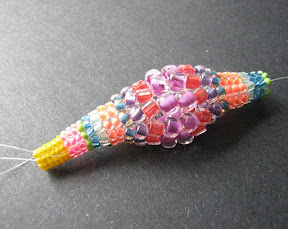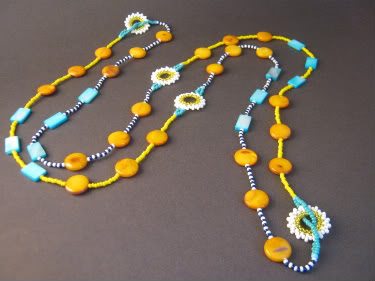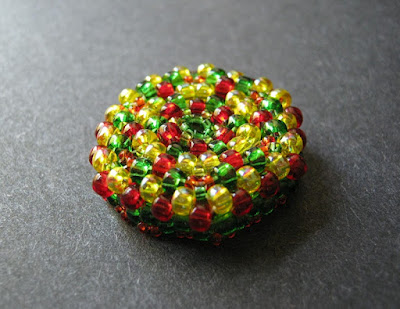Have you ever been completely smitten with shaped seed beads, only to find yourself at a loss when it comes to using them? One of my favorite techniques for combining a variety of seed bead sizes and shapes is tubular herringbone weave. Not only can you use up a lot of beads at once, but the possibilities for color and pattern combinations are endless!
This technique, which I like to call ‘herringbone bobbles’ uses at least two seed bead sizes, or as many as you can come up with. The only restriction is that the beads need to gradually change in size. You can begin as small as you like, although for the best durability, I recommend going no smaller than standard size 11/o Delicas. While 15/o round seed beads could fit into a sequence nicely, the smallest sections of a graduated herringbone rope bear the most pressure and wear, and cylinder beads provide a lot of compact strength.

When choosing your beads and pattern, look carefully at the sizes to determine the best sequence for increasing and decreasing your rope. I like variations of: Delicas - 11/o rounds - 10/o rounds or 11/o triangles - 8/o rounds or hex cuts - 6/o rounds - 4 mm cubes - 4/o rounds or E beads. When in doubt, try stitching a few rows to see how it looks - you can always remove stitches if you don’t like the shape of the beadwork. Combining Czech and Japanese seed beads will give you the widest range of bead sizes.

To Make a Herringbone Bobble Rope:
Begin by weaving a regular
tubular herringbone base. Using your smallest beads, create a two-bead ladder with an even number of stitches. Eight columns is an ideal size for this technique. Ladder stitch the ends of the strip together, and weave through a few columns to secure the ring. Exit from the opposite side from your tail thread.



Pick up two small beads, and stitch down through the adjacent bead in the previous round. Pull snug, and stitch up through the next bead in the base. Continue all around the ring, and step up through 2 beads to begin the next round.
Add several more rounds of tubular herringbone with this bead size, until you have a comfortable base to work with. Make it as long or as short as you like before adding the first increase. If you’re making a necklace, consider where you would like the first ‘bobble’ to appear.



Move up to the next bead size in your pattern, and add 2 or more rows of tubular herringbone. If you will be using more than 3 bead sizes in your rope, giving the smallest bead sizes at least 2 rows each is ideal, to give the larger, roomier rows a strong base.
Continue adding new rows of tubular herringbone, gradually increasing bead sizes as you go. The more variety of beads you have, the more elongated your bobbles will be, especially if you use the same bead for more than one row.



Doubling up on rows can also help make smoother transitions from one bead size to another, just like in
spiral peyote. For a strong but flexible rope, ease into larger size jumps by adding lots of transition rows.



Bigger beads can change the structure of the rope - really big bobbles can be squishy in the middle. Make sure to use strong, even tension as you increase your bead sizes. When you have reached the largest bead size in a sequence - or if your stitches feel like they’re starting to roam - reinforce the row by repeating the herringbone stitches all the way around, without picking up any beads. This dummy stitch will tighten things up before the decrease begins, and add strength to the finished design. I like to keep my tails extra long, so that I can go back and reinforce any loose areas once the rope is finished. Reinforcing sharp-edged rows like cubes and hex-cuts is a good idea, too!



To decrease, add new rows of tubular herringbone, but move down in bead size. You can use the same pattern as the increasing rows, or change it up a little for a more freeform look. You don’t have to go all the way up or down the size scale, either. Moving back and forth in short sections of the bead sequence works, too, as long as you don’t jump sizes too much.
Small accent beads can also be added to the rope, provided they are similar in size to the adjacent seed beads. Try crystals, druks, daggers, or even bugles! When you’re ready to finish the rope, decrease all the way back down to the smallest bead size, and stitch a few rows. Dummy stitch the last row to the previous one, and weave in your tails to add strength.

Do you like to weave with shaped seed beads? What’s your favorite style?
Copyright 2012
Inspirational Beading
Subscribe to Inspirational Beading
Get inspired on
Facebook and
Google+


























































